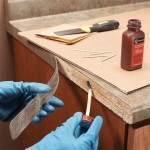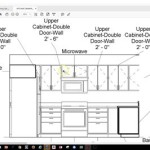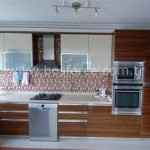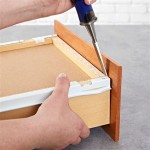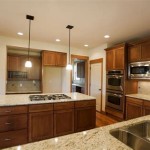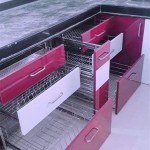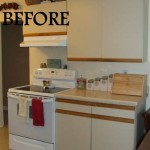What Is A Kickboard In Kitchen?
A kickboard, also frequently referred to as a plinth, is a fundamental component of kitchen cabinetry. It serves both functional and aesthetic purposes. Positioned at the base of the cabinets, along the floor, it's a seemingly minor detail that significantly impacts the overall look and usability of the kitchen space. Understanding its purpose, construction, and design considerations is crucial for anyone involved in kitchen design, renovation, or installation.
The kickboard is typically a flat, horizontal panel that runs along the bottom of the base cabinets, recessed slightly from the cabinet doors. This recess creates a shadow line and a toe-kick space, which is essential for comfortable standing while working at the countertops. Without this toe-kick space, users would be forced to stand further away from the counters, leading to back strain and reduced efficiency.
The material used for kickboards varies depending on the overall design and budget of the kitchen. Common materials include wood, wood composites (such as MDF or plywood), and sometimes even metal or plastic. The material's durability, resistance to moisture, and ability to match or complement the cabinet finish are all important factors in its selection.
The installation of kickboards is typically one of the final steps in kitchen cabinet installation. They are usually attached to the base cabinets using screws, clips, or adhesive. Precise cutting and fitting are necessary to ensure a seamless and professional appearance. Gaps or uneven edges can detract from the overall aesthetic and potentially allow moisture or debris to accumulate behind the cabinets. The top edge of the kickboard should align with the bottom of the cabinet doors, and the front edge should be recessed to create the standard toe-kick dimension.
Functionality of a Kickboard
The primary function of a kitchen kickboard is to create a toe-kick space. This seemingly small detail is crucial for ergonomic comfort when standing at the kitchen counter for extended periods. The toe-kick allows the user to stand closer to the counter, reducing the strain on their back and shoulders. It also allows for a more natural and comfortable posture while performing kitchen tasks such as food preparation, dishwashing, or cooking.
Beyond ergonomics, kickboards also serve a protective function. They prevent shoes and other objects from scuffing or damaging the base of the cabinets. They also help to conceal the legs or supports of the cabinets, creating a more streamlined and finished look. In some cases, kickboards can also help to protect the cabinets from moisture damage, particularly in areas prone to spills or leaks.
Furthermore, kickboards contribute to the overall stability of the cabinet structure. By connecting all the base cabinets together along the floor, they provide additional support and prevent the cabinets from shifting or settling over time. This is especially important in older homes where the floors may not be perfectly level.
The accessibility of hidden storage is another evolving function of kickboards. Some modern kitchen designs incorporate drawers or compartments integrated into the kickboard space, offering valuable additional storage for items such as baking sheets, cutting boards, or infrequently used kitchen tools. These integrated storage solutions maximize space utilization and improve the overall functionality of the kitchen.
Aesthetic Considerations for Kickboards
From an aesthetic standpoint, the kickboard plays a vital role in defining the style and character of the kitchen. The choice of material, finish, and design can significantly impact the overall look and feel of the space. Kickboards are available in a wide range of styles, from simple and minimalist to ornate and decorative, allowing homeowners to customize their kitchen to suit their personal taste.
Matching the kickboard to the cabinet doors is a common design choice, creating a cohesive and unified appearance. However, contrasting kickboards can also be used to add visual interest and create a focal point. For example, a dark kickboard can ground the cabinets and provide a sense of stability, while a light-colored kickboard can brighten the space and create a more airy feel.
The height of the kickboard can also affect the overall aesthetic. Taller kickboards can make the cabinets appear more substantial and grounded, while shorter kickboards can create a more sleek and modern look. The standard height for a toe-kick space is typically around 4 inches, but this can be adjusted to suit the specific needs of the users and the overall design of the kitchen.
The integration of lighting into the kickboard is another popular design trend. LED strip lighting can be installed behind the kickboard, creating a soft and ambient glow that illuminates the floor and adds depth to the space. This type of lighting can also serve as a practical safety feature, providing illumination for nighttime navigation in the kitchen.
Seamless integration with flooring is also a crucial aesthetic consideration. The kickboard should be carefully installed to create a smooth and flush transition with the flooring material. Gaps or uneven edges can detract from the overall appearance and create a potential tripping hazard. The material and color of the flooring should also complement the kickboard and the rest of the kitchen cabinetry.
Materials and Construction of Kickboards
The material selection for kickboards is influenced by factors such as durability, moisture resistance, aesthetics, and cost. Wood and wood composites are the most common choices. Solid wood offers the advantage of natural beauty and durability, but it can be more expensive and susceptible to moisture damage if not properly sealed. MDF (Medium Density Fiberboard) is a popular alternative, offering a smooth and stable surface that is ideal for painting or laminating. Plywood is another option, providing a good balance of strength, stability, and affordability. However, the exposed edges of plywood may require additional finishing to prevent moisture penetration and ensure a clean appearance.
Plastic and metal are also used in some kitchen designs. Plastic kickboards are highly resistant to moisture and easy to clean, making them a practical choice for high-traffic areas. Metal kickboards, often stainless steel, offer a sleek and modern look and are also very durable. However, they can be more expensive than wood or plastic alternatives.
The construction of kickboards typically involves cutting the material to size, shaping the edges (if desired), and applying a finish. The edges may be rounded or beveled to create a softer look or to prevent sharp corners. The finish can be paint, stain, laminate, or veneer, depending on the material and the desired aesthetic. It's crucial to apply a durable and water-resistant finish to protect the kickboard from spills and moisture damage.
The method of attachment to the base cabinets can vary depending on the design and the installer's preferences. Screws, clips, and adhesive are all commonly used. Screws provide a secure and reliable connection, but they may be visible if not properly concealed. Clips offer a cleaner look, but they may not be as strong as screws. Adhesive can be used to create a seamless and invisible connection, but it's important to use a high-quality adhesive that is specifically designed for this purpose.
Proper sealing and caulking are essential to prevent moisture from seeping behind the kickboards. This is particularly important in areas prone to spills or leaks, such as around the sink or dishwasher. A bead of caulk should be applied along the top edge of the kickboard, where it meets the base of the cabinets, and along the bottom edge, where it meets the floor. Additionally, any gaps or cracks should be filled with caulk to create a watertight seal.

Not All Kickboards Are Equal Rod S Kitchens

Kickboards Old Or New School Mdc Furniture Design

Kick Off How To Make The Most Of Kitchen Kickboards Houzz Au

Kitchen Storage Tips And Tricks

Bespoke Plinth Faktum Ltd

How To Make The Most Of Your Kitchen Kickboards Houzz

All About Brushed Stainless Steel Kitchen Kickboards The Door Company

Maximum Length Of Kickboards Kaboodle Kitchen

Le Coop De Pigeon Delicate Kickboards Black Kitchens Bathrooms

Kitchen Plinths Kickboards Plain Or Torus Plinth
Related Posts

